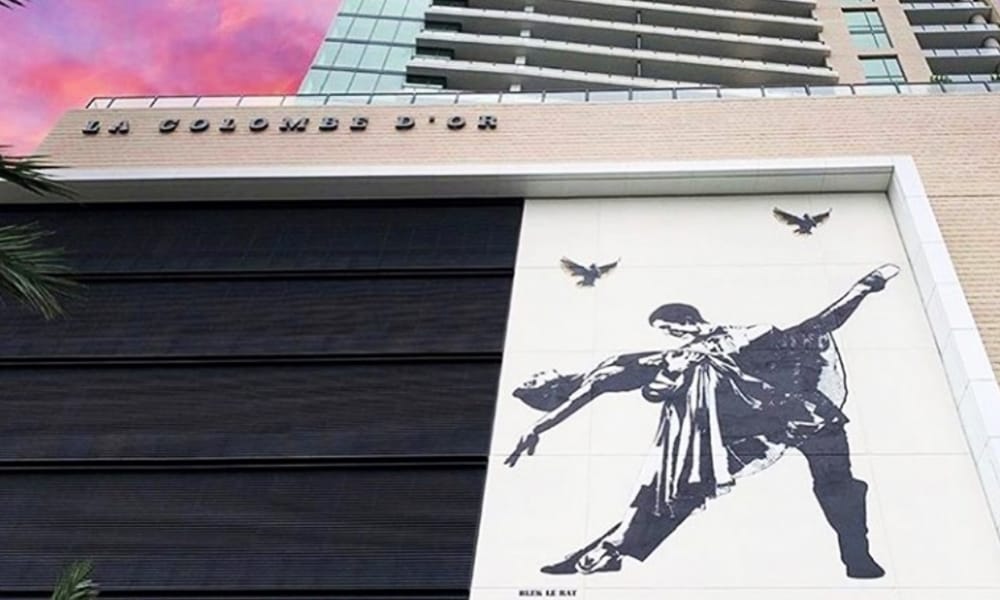Categories
Get Social
Current Weather
77°
Mostly cloudy

Two buildings tango with Houston’s newest mural
Assistants of French stencil graffiti artist Blek le Rat painted the 46-foot-tall “Last Tango” on the Residences at La Colombe d’Or.
Blek le Rat, “the father of stencil graffiti,” lives in France but last week completed the largest mural of his life, in Houston, at the age of 69. “Last Tango,” a black-and-white image of ballet dancers performing a tango-inspired dip, fills a 46-foot-tall facade panel of the ultra-contemporary new Residences at La Colombe d’Or, a 34-story apartment and boutique hotel tower on Montrose Boulevard. The redevelopment project itself expresses a kind of “it takes two to tango” sensibility, since the new high-rise is connected at the hip to the graceful early-20th-century mansion that held the original La Colombe d’Or hotel and restaurant.
Probably needless to say, this is a far cry from Blek’s youthful work on the streets of Paris, when his signature — a leaping rat — aptly illustrated his initial mode of working illegally. The big Houston wall was commissioned by Hines, the Zimmerman family and TIAA Global Asset Management and managed by Weingarten Art Group; it involved an international collaboration among the artist, a stencil maker in Los Angeles and a team of assistants.
Blek, a gentle-looking family man whose real name is Xavier Prou, has been stuck at home about 50 miles from Paris since the COVID-19 pandemic began. So he did not actually paint the wall himself. It’s killing him that he has not been able to see the huge mural in person, although he hopes to revisit Houston one day soon to add his famous signature. Even if he could have traveled, Blek says, the size was daunting. “It was good that someone who knows how to work at that scale could help.” A team of street artists from Nashville applied the paint, piecing together the monumental image from about 140 stencils, laying down the black first, then an overlay of white. A pair of doves with golden wings flies over the dancing couple, a reference to the name of the property, which translates to “golden dove.”
Well before he knew he would become a street artist, during a trip to New York as an adolescent, Blek was taken by early graffiti on subway walls and buildings. He studied engraving and painting at the School of Beaux Arts in Paris but didn’t much like it. He switched to architecture and began to think about how people in cities interact with buildings that are often plastered with advertisements. “It took me 10 years to digest all the things I saw in New York,” he says.
When Blek graduated in the early 1980s, Jean-Michel Basquiat and Keith Haring had hit the big time in America. But Europe had no graffiti artists, and Blek liked the idea of having his work seen by thousands of people. “Actually, I wanted to be famous,” he says, chuckling, “and it was a good way to get famous very easily.” He worked with stencils because he is not very good at freehand work, he says. “I prefer to work in my studio, create a stencil, then go in the street and paint with something already prepared.”
He and his friend Gérard Dumas worked together the first year, in 1981, signing their work “Blek” to keep their identity anonymous. (“Blek le Roc” was an Italian comic strip they’d liked as kids.) After Dumas dropped out, Blek kept the name. He had little competition until 1984, when graffiti began to proliferate and became illegal, but it was a thrillingly underground activity. Blek feels nostalgic for those days when he worked for free, but he does not miss running from the police. He’s not into any kind of political provocation. “I don’t want to make horrible, aggressive images,” Blek says. “I prefer to give people some happiness.”
He purchased the tango image from a British photographer and has adapted it recently in smaller murals in France, Germany and Italy — minus the dove with golden wings. “This image is about something positive,” Blek says. The partners liked Blek’s design because it reflects the ethos of the Residences at La Colombe d’Or project. “This is a place where people can come together and enjoy life. That appealed to us more than abstract possibilities or landscapes,” says Dan Zimmerman, who redeveloped his family’s property with his father, Steve Zimmerman. The image strikes a balance between fine and street art and also the owner’s different generations, adds Lea Weingarten, the consultant. “It’s an art historical image being used as street art.” Zimmerman notes that tango is inherently democratic, often performed in the streets, so the image also speaks to the democract of street art — and his project.
“This is on a major street where everybody can enjoy it… It’s a surprise, a gift for a lot of people,” he says. Zimmerman says his own loveaffair with art began just a few years ago when he bought a piece from Blek. The artist was making the rounds across the U.S. that included a show at La Colombe d’Or’s gallery. He stayed in the hotel and painted one of his smaller “Pied Piper” images on a wall down the street at Bar Victor, another Zimmerman property.
Blek, for his part, was impressed with the old-school Impressionist art in the hotel’s collection. “When you have lunch there, you can eat within view of a Corot painting — it’s an incredible thing,” he says.
The apartments already have their first tenants, who will share amenities with hotel guests in both buildings. The Zimmermans still own and operate the mansion, whose $10 million makeover has been delayed a bit by the pandemic. They hope to have it reopened, with a new restaurant and boutique hotel, by the end of the year. The family’s art collection will be back — and expanded. Zimmerman hopes to create partnerships with area museums that might include artists’ residencies. “We want it to be a dynamic art experience,” he says. “Art is in the DNA of the whole project.”
—HOUSTON CHRONICLE: Story by Molly Glentzer, Photography by Mark Mulligan



